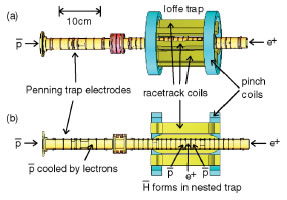| "When antihydrogen is formed in an ion trap, the neutral atoms will no longer be confined and will thus quickly strike the trap electrodes. Resulting annihilations of the positron and antiproton could be monitored. ..." | "... it is clear that the very low [antihydrogen production rate] will make ... experiments with antihydrogen to be very ... difficult. For me, the most attractive way ... would be to capture the antihydrogen in a neutral particle trap ... The objective would be to then study the properties of a small number of [antihydrogen] atoms confined in the neutral trap for a long time." |
| Tick marks: 1 meter Positron accumulator accumulates positrons from a 22Na source Time axis |
Cold positrons and cold antiprotons are accumulated in Penning traps located within a 1-3 Tesla solenoid (below left) Antiprotons come from the CERN Antiproton Decelerator (AD) storage ring |
| 0 Seconds: Antiprotons load |
30 Seconds: Positrons load |
70 Seconds: More positrons load |
100 Seconds: Cycle starts over |
| Scintillation detectors |  |
 |
Anihydrogen is produced within a Ioffe trap by either of two methods that ATRAP developed (method 1, method 2, traps for antihydrogen) |
|
|
Note: everyone at ATRAP helps out as needed on whatever part of the project needs help, so these divisions are often blurred
Dr. Jonathan Wrubel supervises much of the Harvard activity at CERN. He designed and operated our new 1.2 K system. Philippe Larochelle is writing his thesis after demonstrating that we can non-destructively detect a single antiproton, and thus (we hope) an single antihydrogen ion. Robert McConnell is leading our efforts to see if we can trap antihydrogen atoms produced by laser-controlled charge exchange. Steve Kolthammer is building a new apparatus which includes our second generation Ioffe trap. Philip Richerme is helping with this and investigating methods of manipulating antihydrogen atoms.
© 2015 - Last Updated: 09/05/2018 - Disclaimer